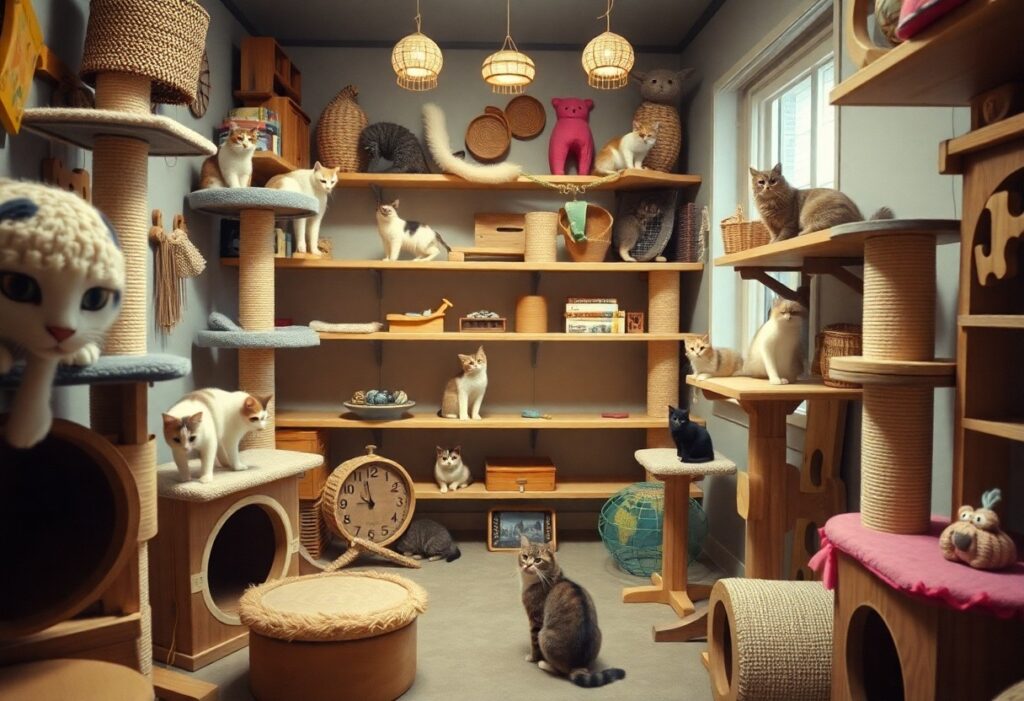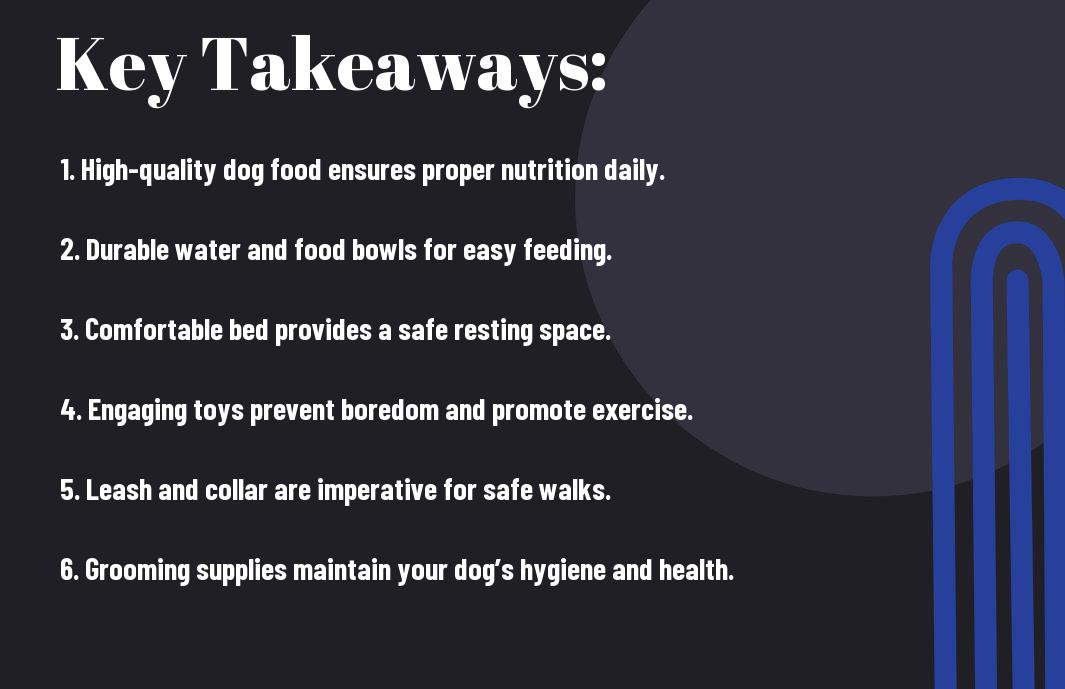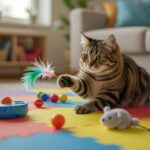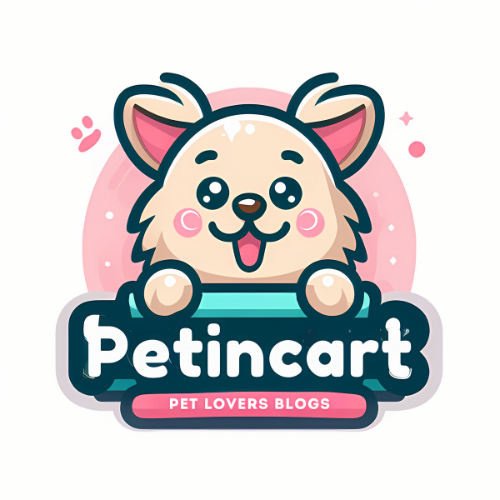You might not realize how important it is for your cat to stay active while indoors. Engaging in playtime not only helps to maintain your cat’s physical health, but it also combats boredom and keeps their mental faculties sharp. By providing a stimulating environment, you can prevent the development of behavioral issues and obesity, ultimately contributing to a longer, healthier life for your feline friend. Discover how creating an active indoor play schedule can enhance your cat’s well-being and strengthen your bond.
Key Takeaways:
- Indoor play helps maintain your cat’s physical health by providing necessary exercise that can prevent obesity and related health issues.
- Engaging your cat in interactive activities enhances their mental stimulation, reducing the likelihood of boredom and associated behavioral problems.
- Providing a safe and enriching indoor environment fosters a strong bond between you and your cat, promoting emotional well-being and overall happiness.

The Importance of Physical Activity for Cats
For your cat, regular physical activity is vital for maintaining overall health and well-being. Engaging your feline friend in various indoor play activities can prevent obesity, reduce stress, and promote a happy, healthy lifestyle. By providing opportunities for exercise and stimulation, you ensure that your cat remains physically fit and mentally alert, which is vital for their long-term happiness.
Health Benefits
Along with keeping your cat’s weight in check, consistent physical activity can help prevent various health issues, such as diabetes and heart disease. It can also enhance their immune system and improve their overall quality of life, leading to longer, happier years by your side.
Behavioral Benefits
About engaging your cat in indoor play, you’ll discover that it significantly reduces negative behaviors, such as scratching furniture or excessive meowing. When your cat has outlets for their energy and instincts, they are more likely to exhibit desirable behaviors, making your home a more peaceful environment.
A properly exercised cat will have a more balanced temperament, reducing the likelihood of destructive behavior caused by boredom or pent-up energy. Providing stimulating toys and engaging play sessions can turn your feline into a well-adjusted companion. Additionally, regular play helps to strengthen the bond between you and your cat, ensuring a happier and more harmonious relationship. Bear in mind, an active cat is a content cat, paving the way for a more enjoyable living environment.
Types of Indoor Play
Even in a small space, there are numerous opportunities for your cat to stay active and entertained at home. Different kinds of indoor play can keep your feline engaged and happy. Here are some options:
| Type of Play | Description |
|---|---|
| Interactive Toys | Toys that encourage participation and mental stimulation. |
| Engaging Activities | Activities that require your cat to think and problem-solve. |
| Homemade Games | Using everyday items to create exciting games. |
| Chasing Games | Activities that stimulate your cat’s natural hunting instincts. |
| Hide and Seek | An engaging way for you and your cat to bond and play. |
Any combination of these activities can create a stimulating environment, important for your cat’s overall well-being.
Interactive Toys
Behind every fun moment is a choice of interactive toys that challenge your cat’s instincts. These toys often involve movement, sound, or enticing features that make playtime more engaging. Consider options like feather wands, laser pointers, or puzzles that dispense treats, ensuring your cat stays mentally and physically active.
Engaging Activities
The joy of indoor play is amplified through engaging activities that you can easily initiate at home. Explore different types of play that stimulate both your cat’s mind and body.
To keep your feline friend entertained, focus on activities that ignite their natural instincts, such as using interactive toys or engaging them in chasing games. You can create simple scavenger hunts by hiding treats around your home, or build obstacles with homemade items to promote exploration. These activities not only enhance your cat’s physical health but also strengthen the bond between you and your pet, making indoor play a joyful and enriching experience.
Creating a Cat-Friendly Environment
Keep in mind that creating a cat-friendly environment is important for stimulating your feline’s instincts and keeping them active. Incorporate features like climbing shelves, scratching posts, and cozy resting spots to cater to your cat’s natural behaviors. By providing various textures and levels in your home, you can engage your cat mentally and physically, ensuring they remain active and entertained.
Designated Play Areas
Before you start, consider setting up designated play areas in your home where your cat can safely explore and engage in play. Having specific zones for toys, climbing structures, and interactive games encourages your cat to exercise while providing a consistent space for them to enjoy their activities.
Safety Considerations
Before allowing your cat to roam freely in their play area, it’s important to assess the space for potential hazards. Ensure that your setup is free from sharp objects, small items that could be swallowed, and any toxic plants that could harm your cat.
Hence, cat-proofing your home is vital for your pet’s safety. Ensure that all toxic plants, small objects, and electrical cords are out of reach. Additionally, secure heavy furniture to prevent tipping and choose non-toxic toys that pose no choking hazard. By creating a safe environment, you can allow your cat to enjoy their playtime without constant worry, leading to a healthier and happier life.
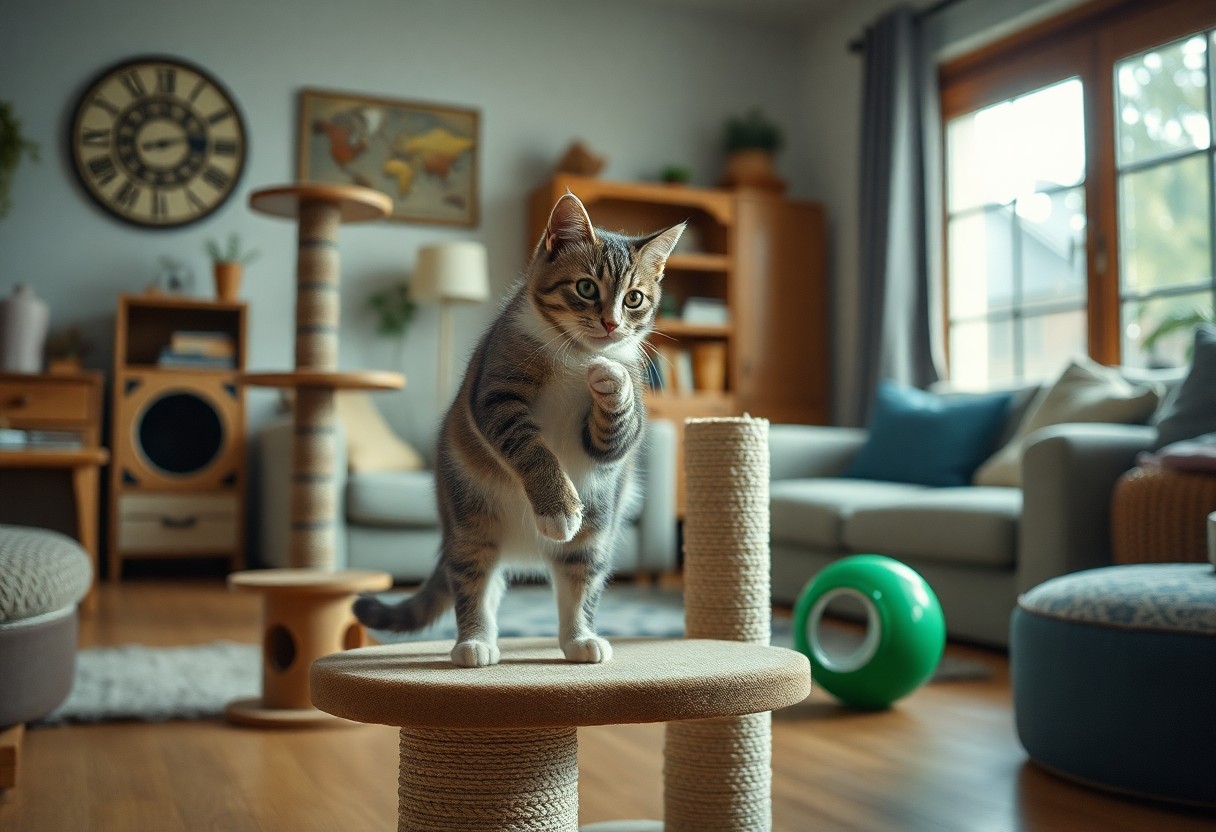
Incorporating Exercise into Daily Routine
After establishing a comfortable space for your cat, it’s crucial to incorporate regular exercise into their daily routine. A consistent activity schedule not only helps manage your cat’s weight but also supports their mental well-being. By setting specific times each day for play, you create an engaging environment that ensures your cat remains active and satisfied.
Scheduled Playtime
Any cat owner can benefit from scheduling dedicated playtime with their feline friend. By allocating specific times during the day for interactive play, you foster an environment of excitement and engagement, ultimately enhancing your cat’s overall health. Consistency is key; aim for at least 15-30 minutes of focused play sessions each day.
Stimulating Games
One effective way to keep your cat active indoors is by introducing stimulating games that engage their natural hunting instincts. These games can include puzzles, laser pointers, or feather toys that encourage jumping, chasing, and climbing.
In addition to fostering physical activity, stimulating games can significantly improve your cat’s cognitive abilities as they learn to solve problems and develop hunting strategies. Various toys and interactive devices are designed to challenge your cat’s mind while keeping them physically engaged. Just ensure the games remain safe—avoid items with small parts that can be swallowed or pose a choking hazard. By providing your cat with engaging and safe game options, you enhance their quality of life and promote enduring health benefits.
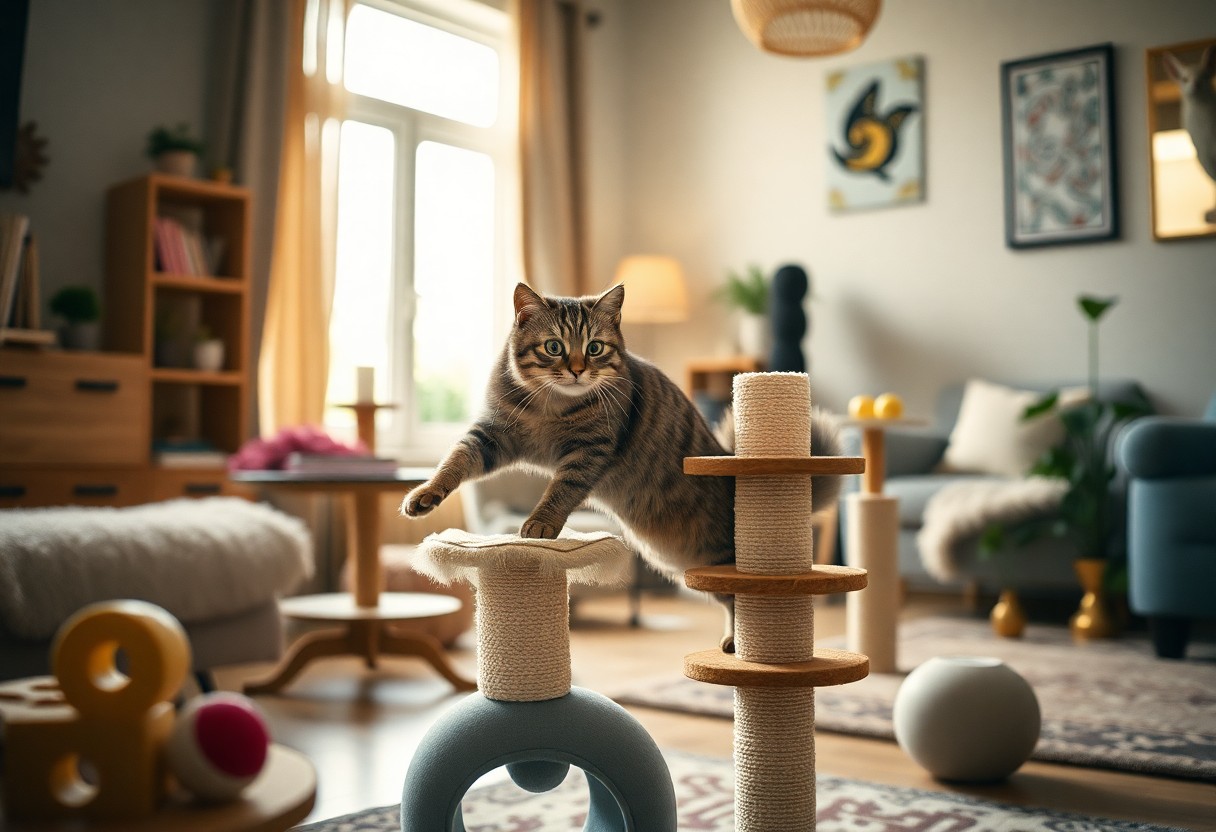
Understanding Your Cat’s Preferences
Despite a common misconception, every cat has its own unique preferences when it comes to playtime. By understanding your cat’s likes and dislikes, you can create an engaging indoor environment that caters to their specific needs. Observing their behavior during play can help you identify what excites them, leading to a more fulfilling and active life at home.
Personality and Play Styles
To tailor your indoor activities effectively, it’s important to recognize your cat’s individual personality and play style. Some cats may enjoy pouncing on moving toys, while others might prefer interactive puzzle feeders. Identifying these preferences allows you to engage your feline friend appropriately.
Tailoring Activities
Above all, adjusting your activities to suit your cat’s unique preferences is key to maintaining their interest and encouraging regular exercise. This can be achieved by selecting toys that align with their instincts, such as feather wands for hunters or catnip mice for those who love to stalk. Additionally, varying play routines will help prevent boredom, keeping your cat active and entertained.
At home, consider setting up different play zones to suit your cat’s energy levels and interests. For active cats, create spaces with climbing structures or tunnels to encourage vertical exploration, while more reserved cats may appreciate cozy nooks for quiet play. Incorporating a mix of interactive toys and solo activities will help maintain your cat’s engagement and encourage healthy exercise habits. Also, dedicating a few minutes daily for playtime can significantly enhance your cat’s mental and physical well-being, making it easier to bond with your furry friend.

Overcoming Common Challenges
All cat owners face obstacles when engaging their feline friends in indoor play. Whether it’s a lack of interest or easily distracted behavior, understanding these common challenges can help you devise effective strategies to keep your cat active and entertained.
Dealing with Reluctant Cats
Challenges arise when your cat shows reluctance to play or engage. This hesitation may stem from anxiety, fear, or simply being less naturally inclined to play. To address this, ensure your home environment feels secure and comfortable, gradually introducing playtime with gentle interactions and enticing toys.
Maintaining Interest in Play
Around the home, you may find your cat losing interest in their toys after a short time. To combat this, regularly rotate toys to keep things fresh and exciting. Incorporate different activities such as puzzle feeders or interactive toys that challenge your cat mentally and physically. Consider using treats during play to incentivize engagement as well.
Due to your cat’s evolving preferences, keeping them engaged can be a task. Be proactive by introducing a variety of activities to keep their interest alive. Use interactive toys that mimic prey or ambitious climbing structures that stimulate their natural instincts. Additionally, utilize short play sessions combined with reward treats to encourage participation. By being attentive to your cat’s likes and adapting your approach, you can create an enriching play environment that fosters enthusiasm.
To wrap up
On the whole, keeping your cat active at home through indoor play not only enhances their physical health but also stimulates their mental well-being. By providing various interactive toys and creating engaging environments, you can help prevent behavioral issues and obesity in your feline companion. Indoor activities foster stronger bonds between you and your cat, enhancing their happiness and overall quality of life. Prioritizing indoor play will ensure your cat thrives in a safe and stimulating environment, allowing you both to enjoy countless joyful moments together.
FAQ
Q: What are the primary benefits of indoor play for cats?
A: Indoor play provides a variety of benefits for cats including physical exercise, mental stimulation, and reducing behavioral issues. Engaging your cat in play helps them burn off excess energy, which can prevent obesity and related health problems. It also stimulates their hunting instincts and curiosity, keeping them mentally sharp and reducing boredom that can lead to destructive behavior.
Q: How can I keep my cat actively engaged in indoor play?
A: There are numerous ways to engage your cat in indoor play. Consider using interactive toys, such as feather wands, laser pointers, or puzzle feeders that encourage problem-solving. Rotating toys regularly can also maintain their interest. Setting up climbing structures or scratching posts can provide additional physical activity and exploration opportunities.
Q: Are there specific types of toys that are recommended for indoor cats?
A: Yes, there are various types of toys that can keep indoor cats entertained and active. Consider toys that mimic prey, such as soft mice, balls, or toys with feathers. Battery-operated or automatic toys can also engage your cat’s hunting instincts. Additionally, toys that require the cat to work for treats or kibble can provide both play and mental challenge.
Q: How often should I play with my cat indoors for optimal health?
A: Ideally, indoor cats should have at least 15 to 30 minutes of active play time each day. This can be divided into several short sessions to fit both your schedule and your cat’s interest levels. Cats are natural hunters and thrive on play, so be responsive to your cat’s cues and engage them more if they show interest.
Q: Can indoor play help in reducing my cat’s stress or anxiety?
A: Absolutely! Indoor play can serve as an excellent outlet for your cat’s energy and stress. Engaging in interactive play helps to focus their attention on something positive, which can alleviate anxiety and reduce the chances of stress-related behaviors, such as excessive grooming or litter box issues. Providing a safe and stimulating environment through play can promote a more relaxed and happy cat.

